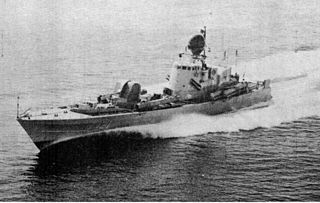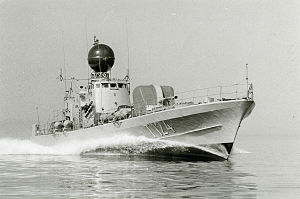
The Swedish Navy is the naval branch of the Swedish Armed Forces. It is composed of surface and submarine naval units – the Fleet – as well as marine units, the Amphibious Corps.

HSwMS Småland (J19) is a Swedish Halland-class destroyer. She and HSwMS Halland were the only ones built of their class. Two more ships were ordered but they were never completed.

HSwMS Gustaf V, in Swedish HM Pansarskepp Gustaf V was a Sverige-class coastal defence ship of the Swedish Navy. The vessel was the third and last ship in the Sverige class along with HSwMS Sverige and HSwMS Drottning Victoria. Gustaf V was launched on 15 September 1917 at Kockums in Malmö and delivered to the Navy on 9 January 1922. The design consisted of four 28 cm cannon and a secondary armament of eight 15.2 cm cannon. During the interwar period, the ship underwent several modernizations and was one of the most powerful vessels in the fleet during the Second World War. The ship was put in reserve in 1948, was decommissioned in 1957 and was later sold for scrapping in Karlskrona. However, the ship remained at Berga Academy of War as of 1968. Two of the ship's 15.2 cm guns are preserved in the battery at Häggmansberget in the defensive Kalix Line, around Kalix.

HSwMS Spica (T121) is a former Swedish Navy Spica-class, torpedo-armed, fast attack craft (FAC), now a museum ship at the Vasa Museum in Stockholm, Sweden.

HSwMS Orion (A201) is a signals intelligence gathering vessel of the Swedish Navy.

HSwMS Belos (A214) is a submarine person helping ship in the Swedish Navy's 1st Submarine flotilla. She carries the Submarine Rescue Vehicle URF. She is also capable of carrying the NATO rescue system NSRS. HSwMS Belos is currently [2017] the largest ship in the Swedish Navy. HMS Belos is traditionally the name of the Swedish Navy's submarine rescue vessel and she is the third ship with that name.

HSwMS Helsingborg (K32) is a Swedish Visby-class corvette. She was ordered by the Swedish Government in 1995 and is the second ship of the class built by Kockums. She has been in active service with the 31st Corvette Squadron, 3rd Naval Warfare Flotilla since 19 December 2009. It is a stealth missile corvette.

HSwMS Härnösand (K33) is the third ship of the Visby-class corvettes ordered by the Swedish Government and built by Kockums. The Härnösand is designed for mine countermeasures and anti-submarine warfare.

HSwMS Sjöormen (Sor), Sw. meaning sea serpent, was the lead ship of the Swedish submarine class Sjöormen, project name A11.
Sweden played a role of major importance during the Cold War, despite not officially participating. Sweden's location made it an ideal base of operations for both the Soviet Union and the United States. Sweden was never invaded throughout the war, mainly due to their strong defensive power - ranked among the top five in the world at this time.

The Spica class was a class of six fast torpedo boats built for the Swedish Navy in the 1960s and decommissioned in the late 1980s. One ship, HSwMS Spica, is preserved as a museum ship in Stockholm, Sweden.
Several ships of the Swedish Navy have been named HSwMS Tordön or HSwMS Thordön, named after the Old Norse word for thunder:

HSwMS Sjölejonet (Sle),, was the second ship of the Swedish submarine class Sjöormen, project name A11.

HSwMS Sirius (T122) was a Swedish Navy Spica-class, torpedo-armed, fast attack craft (FAC).

HSwMS Capella (T123) was a Swedish Navy Spica-class, torpedo-armed, fast attack craft (FAC).

HSwMS Vega (T125) was a Swedish Navy Spica-class, torpedo-armed, fast attack craft (FAC).

HSwMS Virgo (T126) was a Swedish Navy Spica-class, torpedo-armed, fast attack craft (FAC).

HSwMS Halland (J18) was the lead ship of the Halland-class destroyer. She and HSwMS Småland were the only ones built of their class. Two more ships were ordered but they were never completed.

HSwMS Södermanland(J21) was the second ship of the Östergötland-class destroyer.
















